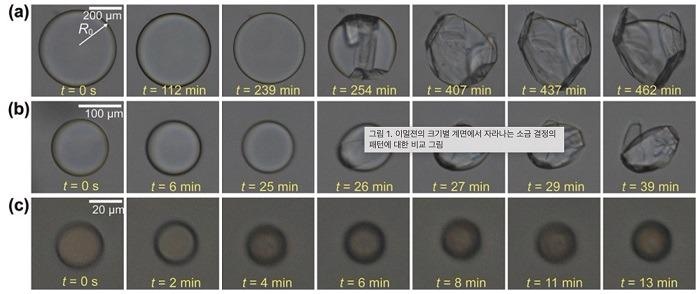Scientists have formulated a method by which they can freely encapsulate microscopic droplets of water and oil emulsion in a minute sphere made of salt crystals — similar to a tiny, self-constructing origami soccer ball packed with liquid.
 Crystal growth at the interface of calcium propionate-saturated water-oil emulsions depending on the initial emulsion size. The initial diameter of the emulsion in oil is (a) 496 μm, (b) 135 μm, and (c) 34 μm. (Image Credit: Korea Advanced Institute of Science and Technology).
Crystal growth at the interface of calcium propionate-saturated water-oil emulsions depending on the initial emulsion size. The initial diameter of the emulsion in oil is (a) 496 μm, (b) 135 μm, and (c) 34 μm. (Image Credit: Korea Advanced Institute of Science and Technology).
The process, which they refer to as “crystal capillary origami,” could be used in numerous fields from more defined drug delivery to nanoscale medical devices. The method is illustrated in an article published in the September 21st issue of the journal Nanoscale.
Most people are familiar with capillary action, or “capillarity,” as the way that water or other liquids can travel up narrow tubes or other porous materials in defiance of gravity (for example, within the vascular systems of plants, or even more basically, the drawing up of paint between the paintbrush hairs).
This effect is down to the forces of cohesion (the propensity of a liquid’s molecules to adhere together), which brings about surface tension, and adhesion (their propensity to adhere to the surface of other substances).
The capillarity’s strength relies on the liquid’s chemistry, the chemistry of the porous material, and the other forces working on them both. For example, a liquid possessing a lower surface tension than water cannot hold up a water strider insect.
Less familiar is an interconnected phenomenon, elasto-capillarity. A process that exploits the relationship between capillarity and the elasticity of a minute flat sheet of a solid material. In some conditions, the capillary forces can surpass the sheet’s elastic bending resistance.
This relationship can be manipulated to develop “capillary origami,” or three-dimensional (3D) structures. When a liquid droplet is positioned on the flat sheet, the latter can instinctively encapsulate the former because of surface tension.
Capillary origami is capable of taking on other forms, such as buckling, wrinkling or self-folding into other shapes. The particular geometrical shape that the 3D capillary origami structure finally takes is established by both the chemistry of the flat sheet and that of the liquid, and by meticulously engineering the size and shape of the sheet.
However, there is one big issue with these tiny devices.
These conventional self-assembled origami structures cannot be completely spherical and will always have discontinuous boundaries, or what you might call ‘edges,’ as a result of the original two-dimensional shape of the sheet. These edges could turn out to be future defects with the potential for failure in the face of increased stress.
Kwangseok Park, Study Lead, Korea Advanced Institute of Science and Technology
Non-spherical particles are also said to be more unfavorable than spherical particles with regard to cellular uptake.
This is why researchers have long been on the hunt for substances that could produce a fully spherical capillary origami structure.
Hyoungsoo Kim, Professor, Department of Mechanical Engineering, Korea Advanced Institute of Science and Technology
For the first time, the researchers exhibited such an origami sphere. They demonstrated how, in place of a flat sheet, the growth of salt crystals can conduct capillary origami action in a comparable way.
What they refer to as “crystal capillary origami” voluntarily creates a smooth spherical shell capsule from these same surface tension effects, but now the unprompted encapsulation of a liquid is established by the elasto-capillary circumstances of growing crystals.
In this study, the term “salt” denotes a compound made up of one positively charged ion and another negatively charged. Table salt, or sodium chloride, is merely one example of a salt. The KAIST scientists used four other salts: calcium nitrate tetrahydrate, sodium salicylate, calcium propionate and sodium bicarbonate to cover a water-oil emulsion.
Generally, a salt such as sodium chloride possesses a cubical crystal structure, but these four salts create plate-like structures as crystallites or “grains” (the microscopic shape that develops when a crystal first begins to grow) instead. Next, these plates self-assemble into flawless spheres.
Using x-ray diffraction analysis and scanning electron microscopy, they examined the mechanism of such formation and decided that it was “Laplace pressure” that triggers the crystallite plates to envelop the emulsion surface.
Laplace pressure defines the pressure difference between the exterior and interior of a curved surface as a result of the surface tension at the interface between the two materials, in this case between the oil and the saltwater.
The scientists anticipate that these self-assembling nanostructures can be employed for encapsulation applications in a variety of sectors, from the cosmetics and food industry to drug delivery and even miniature medical devices.
Journal Reference:
Park, K & Kim, H (2021) Crystal capillary origami capsule with self-assembled nanostructure. Nanoscale. doi.org/.10.1039/d1nr02456f.